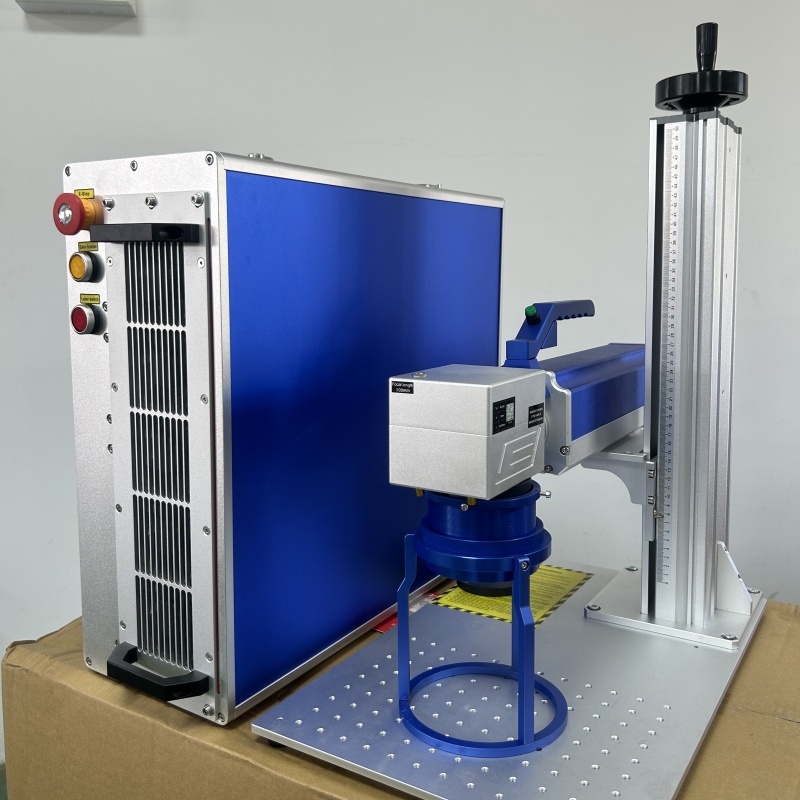In manufacturing, laser marking machines have become mainstream equipment due to their advantages of permanent marking, high efficiency, and environmental friendliness. Fiber, ultraviolet, and CO₂ lasers dominate the market, but they differ significantly in their technical principles and suitable application scenarios. Choosing the wrong model can lead to poor marking results and wasted costs. Below, we explain the selection logic for these three types of machines in detail, considering material characteristics, processing requirements, and cost budgets, to help companies accurately match equipment.
Fiber laser marking machines are the preferred choice for metal processing. They use a 1064nm infrared laser to mark metal surfaces by vaporizing them. Marking accuracy can reach ±0.02mm, and they can operate continuously at full load for 72 hours without attenuation, making them ideal for metal processing scenarios with high durability requirements. For marking serial numbers on automotive parts, brand logos on hardware and building materials, and traceability codes on electronic chips, fiber laser marking not only produces clear marks but also resists harsh environments such as oil stains and high temperatures. For power selection, 20-50W models are sufficient for general shallow metal marking. For deep engraving of mold numbers or other processes requiring a depth of 0.1mm or more, a high-power model of 100W or higher is necessary. This model boasts extremely low maintenance costs, a laser lifespan exceeding 100,000 hours, and no consumables, making it particularly suitable for long-term use in small and medium-sized metal processing plants and heavy machinery manufacturing enterprises.
CO₂ laser marking machines are powerful tools for high-speed marking on non-metallic materials. They output 9.3-10.6μm far-infrared laser light, utilizing the thermal effect on materials. With a laser tube lifespan exceeding 80,000 hours, they can achieve high-speed marking at 200 meters per minute, suitable for non-metallic materials such as food packaging, paper labels, and plastic films. For example, production dates on mineral water bottles, brand logos on potato chip bags, and logistics codes on cartons can all be marked efficiently. Its advantages also lie in its controllable cost, with operating costs 60% lower than inkjet printing. It also supports 360° rotating marking and can handle irregularly shaped non-metallic workpieces such as eggs and pen barrels. However, its spot size is relatively large, typically between 50-100μm, suitable for medium-precision needs. Those seeking ultra-fine marking should choose carefully, and a ventilation system is required to handle small amounts of vaporized fumes during processing.

UV laser marking machines are experts in the precision processing of heat-sensitive materials. They achieve cold processing with a 355nm UV laser, resulting in a very small heat-affected zone. The smallest spot size is only 10μm, and the marking accuracy reaches ±0.001mm, avoiding deformation and damage to heat-sensitive materials. There is a strong demand for it in pharmaceutical aluminum-plastic composite panels, cosmetic acrylic packaging, and semiconductor components. For example, Guilin Nanfang Pharmaceutical uses it for marking pharmaceutical packaging; the markings showed no detachment after water rinsing tests and can withstand high-temperature sterilization processes. In the electronics industry, only this type of machine can meet ultra-precision requirements such as micron-level circuit marking on wafer surfaces and 0.1mm micro-character marking on electronic components. Its power is mostly 3-20W, with 3-5W models sufficient for most precision machining needs. However, the cost of replacing core components is higher, and the initial purchase price is also higher than the previous two types of models, making it more suitable for pharmaceutical and high-end electronics companies with stringent precision requirements.
When selecting a model, budget and long-term costs must also be considered. CO₂ models have the lowest purchase price, starting at 30,000-100,000 RMB, suitable for small and medium-sized FMCG companies with limited budgets; fiber optic models cost 50,000-200,000 RMB, suitable for companies with long-term metal processing experience; UV models cost 100,000-300,000 RMB, with a higher initial investment, but can meet the processing needs of high-value-added products. It is also recommended to request sample testing from the manufacturer before selection. For example, for metal processing, the adhesion of fiber optic models can be tested, and for precision machining, the precision stability of UV models can be verified.
In summary, fiber optic laser marking machines are preferred for metal processing, CO₂ models are suitable for high-speed marking of non-metals, and UV models are the best choice for precision machining of heat-sensitive materials. A comprehensive assessment considering the material being processed, required precision and speed, and budget is essential to ensure that laser marking machines fully realize their value and contribute to increased production efficiency.




